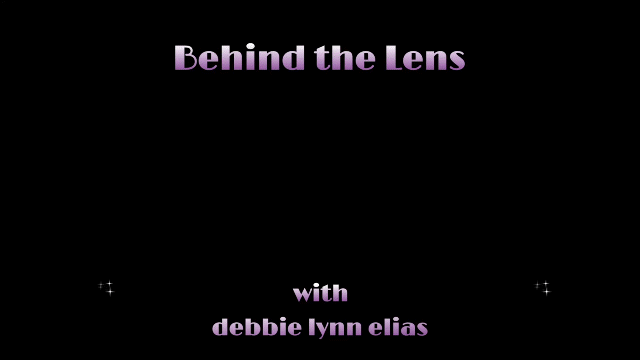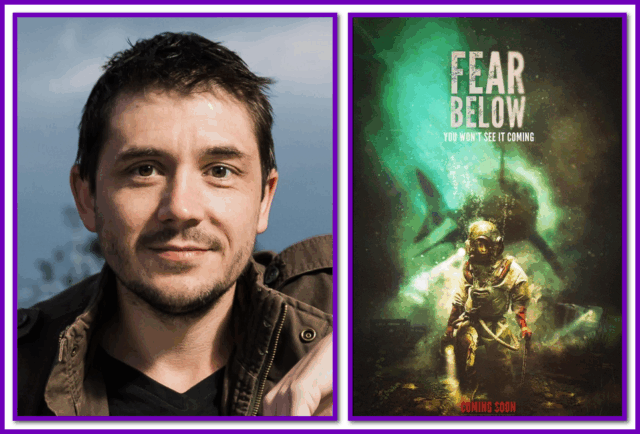
Writer/Director MATTHEW HOLMES discusses the “making of” FEAR BELOW, including the challenges of a 1946 period piece, the unpredictability of Mother Nature, and the benefits of practical effects, puppetry, and the magic of shooting “dry for wet”.
SYNOPSIS: When a gang of ruthless criminals loses their stolen gold in a river, they turn to a team of desperate, down-on-their-luck divers to retrieve it. What begins as a high-stakes recovery mission quickly spirals when the divers soon find themselves in the company of a vicious bull shark, but the dangers in the water are only a fraction of the dangers that wait for them above.
Directed by MATTHEW HOLMES and co-written by Holmes and Gregory Moss, FEAR BELOW stars Hermione Corfield, Jake Ryan, Josh McConville, Jacob Junior Nayinggul, Arthur Angel, Maximillian Johnson, and Clayton Watson.
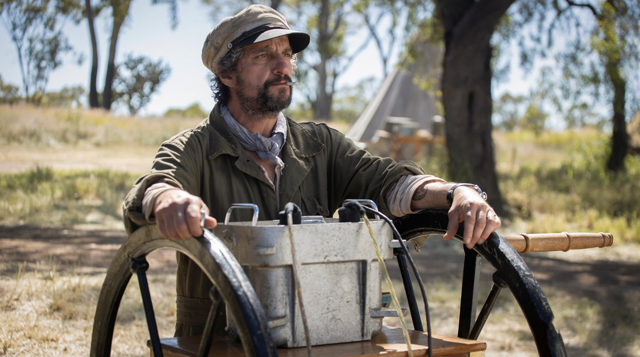
As my longtime readers and listeners know, give me a movie with a shark and I am one happy “movie shark”. But, give me a crime story that just happens to have a shark in it, that’s set in some of the most dangerous inland territory of Australia (which means sharks swimming in an inland fresh water river and not in the ocean), and populate the film with period perfect authenticity and high production values, and my excitement, interest, and joy reaches the sky. And that’s exactly what MATTHEW HOLMES gives us with FEAR BELOW, one of my favorite films of the year.
Matthew is articulate, energetic, and passionate about his craft, the art of filmmaking, and about storytelling, starting his career in stop-motion animation and moving onward and upward from there into directing, something that serves him well with FEAR BELOW and influenced the film’s practical approach.
As we dove into the “making of” FEAR BELOW in this exclusive interview, Matthew broke down the various production and story elements that give us this wonderful film. Set in 1946 Australia, the film’s unique setting and period, along with its practical effects and character-driven plot, were key to its creation. Emphasizing the challenges of filming, including flooding delays and location changes, and using dry-for-wet techniques for underwater scenes, the film’s visual effects, such as the shark’s teeth and underwater scenes, were achieved through practical methods. The cast, including Jacob Junior Nayinggul, Hermione Corfield, Arthur Angel, and Jake Ryan, brought depth to their roles.
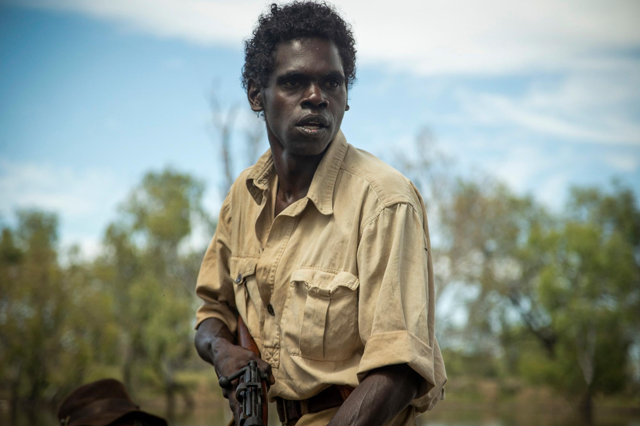
Inspired to write a shark film after a producer suggested he could always sell a shark movie, Matthew wanted to create a unique shark film that hadn’t been done before. His interest in deep-sea diving, particularly the old-style diving with large helmets, led him to set the story in 1946 and create a scenario where divers would be forced to repeatedly enter the water. He aimed to make a film that was more than just a typical shark movie by focusing on compelling characters and a unique setting – an inland river in Australia during the post-World War II era.
As you’ll hear Matthew discuss, casting wasn’t too difficult, but for the role of Clara. They initially offered the role to many Australian actresses but were turned down, eventually casting Hermione Corfield. The role of Ernie, the dive shop owner, was specifically for Arthur Angel, whom he had worked with before. Jacob Junior Nayinggul was cast as Jimmy after Holmes saw him in Stephen Johnson’s High Ground, believing him perfect for the role. Jake Ryan was recommended to him and quickly seen as the ideal choice for the heavy bad guy role of Bull Maddock. For other roles like Clayton Watson’s character Bob, Holmes had recently worked with him on a previous film and brought him in.
Unlike the somewhat ease of casting, finding the right location was something completely different, thanks to horrendous weather and massive flooding during their first week of shooting. The river they originally planned to use broke its banks, and every location was flooded, forcing production to be delayed by about six weeks while they searched for a new river location. They specifically looked for a river that was far inland from Brisbane, Queensland, and critically, they had to ensure there were no bull sharks or crocodiles in the area. They ultimately found a little estuary about four hours inland from Brisbane. According to Matthew, and as you see on screen, the location was very much “out in the wild” – in the middle of nowhere, with actors dealing with flies, mosquitoes, bullfrogs, and snakes. The authenticity came from shooting in a real, remote natural location that was very much “in the mud” with all the natural elements of the Australian wilderness.
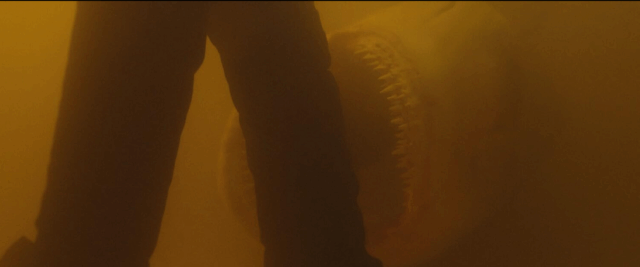

One of the most interesting aspects of FEAR BELOW was Matthew’s decision to shoot what is known as “dry for wet”. You’ve heard of day for night and night for day, but “dry for wet” may be new to most of you. This is where underwater scenes are shot on stage or in a contained tank with no water. Matthew was adamant about using “dry for wet” techniques from the beginning. They shot actors on a set, using specific techniques to simulate underwater movement; to wit, shooting at a faster frame rate and slowing it down to create a weightless effect, and teaching actors to walk in a specific way. They actually had to shoot a test first to convince producers it would work. Peter Szilveszter, the cinematographer, carefully lit the set to create a murky, underwater look. Most underwater scenes were actually shot in a five-meter swimming pool on a studio back lot, with water made murky using pigmentation and soy milk. Miniatures, puppetry, and practical effects were also used to create the underwater scenes. The actors were directed to move as if underwater, and then Szilveszter and his team shot at different frame rates to achieve the right movement. By doing this, they could complete underwater scenes in one day, whereas traditional underwater filming would have taken weeks, been more expensive, and potentially unsafe. The goal was to create a natural, authentic underwater look using old-school filmmaking techniques, avoiding digital effects and real shark footage.
Speaking of sharks, Matthew credits his stop-motion background as instrumental in creating the shark in FEAR BELOW. Having worked extensively in practical effects and never learning digital animation, he was comfortable with in-camera techniques. Matthew has a deep commitment to practical, in-camera effects and views practical effects as a vital filmmaking approach, believing they can create more authentic and interesting visual experiences versus the CGI and digital effects more commonly used today. His background made him bold enough to attempt practical shark effects and the dry-for-wet shooting technique. For the bull shark, they used multiple practical methods, including a large full-scale puppet operated by puppeteers for underwater attacks, separate pieces like a fin, tail, and head that could be manipulated underwater by divers, and a small miniature shark puppeteered to swim through frames. Second Unit Director Steven Boyle of Formation Effects was responsible for the shark effects. Extremely important to Matthew was that they deliberately avoid digital shark footage and real shark clips, using only about half a dozen digital enhancements. The goal was to use old-school techniques similar to how Jaws was made, relying on practical effects and in-camera tricks.
A real coup for Matthew and the team was having Frank Zeigler, a professional diving consultant who read the script early on and provided most of the real diving helmets and suits seen in the movie. These were actual, functional hard hat standard diving equipment of the 1946 era owned by Zeigler. Adding to the film’s authenticity is the work of production designer Esther Rosenberg and costume designer Tracy Rose Spark, who each sourced additional period-appropriate items within their budgets. You’ll hear Matthew talk about how Zeigler even helped them understand how the old diving equipment worked, which added to the film’s historical accuracy. This approach of using real, period-appropriate equipment fell right in line with the overall strategy to create an authentic 1940s feel using practical, old-school techniques.

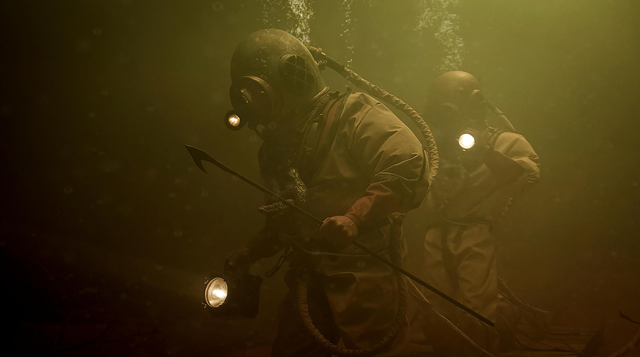
Perhaps the most challenging aspect of making FEAR BELOW was the editing process. Described by Matthew as “quite lengthy and complicated”, due to the flooding that disrupted production and caused budget cuts, they had scenes and shots that couldn’t be filmed as originally intended. This required creative solutions during editing. Heavily involved in the initial editing process, Matthew then passed it off to editors Matt Villa and Sue Schweikert to finalize and tighten up. They had to get particularly creative with shark scenes, and some additional reshoots were done by Steve Boyle’s team to insert and “punch up” shark moments they didn’t have time for during principal photography.
As excellent as the production values are, and as creative and welcome as the practical in-camera effects are, perhaps the most rewarding aspect of the film for Matthew comes from the story itself and the showcasing of female representation and Aboriginal representation by having Clara and Jimmy on equal footing as white males in 1946 Australia. “A deliberate and important” aspect of the film, it was important to Matthew, co-writer Gregory Moss, and the team to make a comment on the racial and sexual discriminations of the 1940s by creating dive shop owner Ernie as a progressive character who sees the potential in women and Indigenous people, despite the prevailing attitudes of the time. In FEAR BELOW, the gangsters represent the typical discriminatory views of the era, treating women and Indigenous people as second-class citizens. In contrast, Ernie brings Clara and Jimmy onto the team because he recognizes their capabilities. It was important to Matthew to explore and touch on the racial and sexual discrimination of the 1940s, showing characters who were ahead of their time in their thinking and treatment of others. By portraying Clara and Jimmy as capable, intelligent, and integral to the mission, they challenged the historical prejudices of the period.
To hear MATTHEW HOLMES talk about all of this and more,
TAKE A LISTEN. . .
by debbie elias, exclusive interview 05/05/25
FEAR BELOW is available on VOD and Digital.

